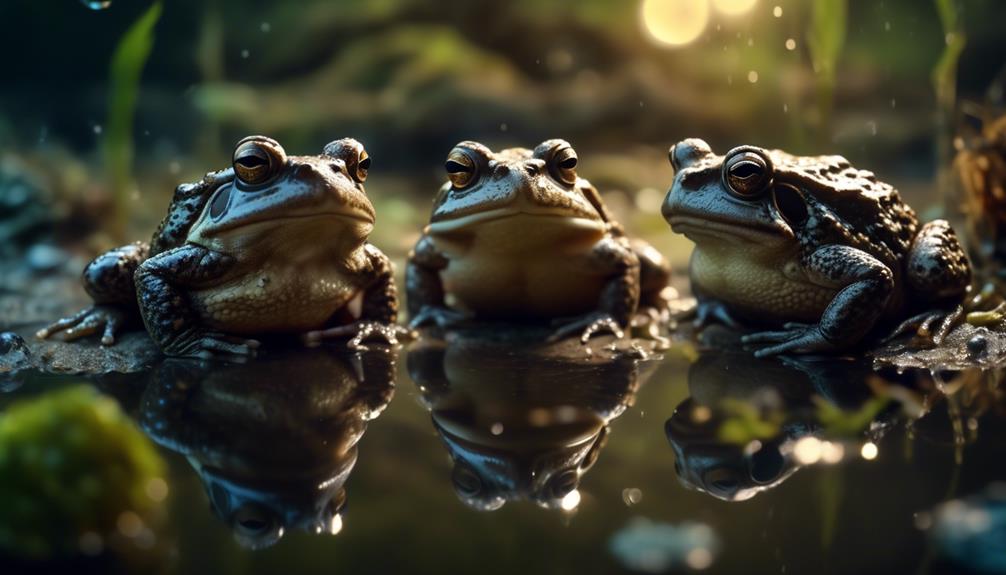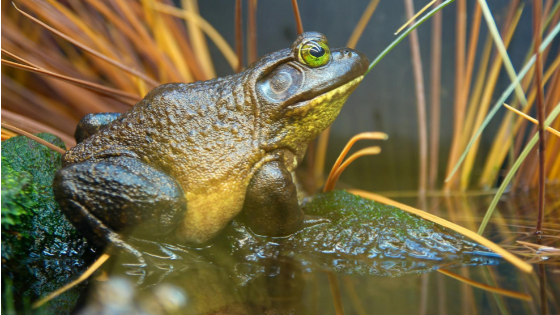
In the realm of nature, there exists a creature that has fascinated and intrigued humans for centuries. With a nod to Shakespeare’s poetic brilliance, one might say that toads are the masters of defense and folklore, for they possess a wealth of adaptations that have allowed them to survive and flourish in the face of adversity.
But their allure goes beyond mere survival strategies; toads have also embedded themselves deeply within the tapestry of human culture, leaving us with tales and symbols that continue to captivate our imaginations.
As this discussion unfolds, prepare to be enthralled by the remarkable world of toads, where their incredible defenses and their place in folklore intertwine in a captivating dance of discovery.
Key Takeaways
- The common toad, also known as Bufo bufo, is a species found throughout Europe, parts of North Asia, and Northwest Africa.
- The toad has various adaptations for defense, including a foul-tasting secretion, toxic paratoid glands, and adopting a defensive stance when attacked.
- Common toads play a role in controlling insect populations as they feed on insects, and their emergence from hibernation is considered a sign of spring.
- Toads have a rich history in folklore and literature, being associated with devils and demons, and featuring prominently in works such as John Milton’s “Paradise Lost” and Kenneth Grahame’s “The Wind in the Willows”.
Taxonomy and Description
The common toad, scientifically known as Bufo bufo, is a species of amphibian that was classified by Carl Linnaeus in 1758. It was later placed in the genus Bufo by Josephus Nicolaus Laurenti in 1768. Various subspecies of B. bufo have been recognized, including B. verrucosissimus and B. spinosus.
The common toad is part of a species complex, along with the spiny toad, Caucasian toad, and Japanese common toad. The exact taxonomic relationships between these species are still unclear.
The common toad can reach about 15cm (6in) in length, with females usually being stouter than males. It has a broad head with a wide mouth and protruding eyes with yellow or copper-colored irises. The paratoid glands, located behind the eyes, contain a noxious substance used to deter predators.
The skin is dry and covered with wart-like lumps, and the color is usually brown, olive-brown, or greyish-brown.
Breeding Behavior and Development

During the breeding season, common toads exhibit unique behaviors and undergo remarkable transformations. Large numbers of toads gather at breeding ponds, where males compete for the opportunity to mate with females. The females lay their eggs in gelatinous strings in the water. These eggs hatch into tadpoles, which then undergo metamorphosis into tiny toads.
After this transformation, the juvenile toads emerge from the water and spend the rest of their lives on land. It takes three to seven years for common toads to reach maturity. However, during their development, the juveniles can be parasitized by the lung nematode Rhabdias bufonis, which can affect their growth and cause anorexia. Additionally, nitrogenous fertilizers in ponds can impact the development of common toad tadpoles.
Despite these challenges, the breeding behavior and development of common toads are fascinating processes to observe.
Distribution, Habitat, and Conservation Status

Common toads can be found in diverse habitats across Europe, western parts of North Asia, and a small portion of Northwest Africa. They inhabit various environments, including woodlands, grasslands, and wetlands.
Imagine a dense forest, with sunlight filtering through the canopy, creating patches of light and shadow. Picture open grassy meadows, with the toads blending in with the green surroundings. Visualize the calm serenity of a marshland, with the toads nestled among the reeds and water plants. These adaptable creatures can also be found near ponds, lakes, and streams, their skin glistening in the water.
Although the common toad is listed as being of least concern in terms of conservation, it faces threats such as habitat loss, road mortality during migrations, and the infectious disease chytridiomycosis.
Predators, Parasites, and Adaptations

Toads employ various defensive strategies against predators and parasites. When attacked, they adopt a defensive stance and their skin produces a foul tasting secretion to deter predators. Hedgehogs, rats, mink, and domestic cats are some of the predators that prey on adult toads, while birds such as herons, crows, and birds of prey also feed on them.
Toads also face threats from parasites like the parasitic fly Lucilia bufonivora, which attack and eat the toads internally. Toads have adapted to survive in different environments and situations. They can see prey at low light intensities, allowing them to hunt in dimly lit areas. They can also survive in deep water, as observed in Loch Ness.
Toads possess paratoid glands that produce a toxin called bufagin for defense, although grass snakes are unaffected by this toxin. Additionally, toad tadpoles exude noxious substances to deter fish, except the great crested newt.
Folklore, Symbolism, and Notable Information

Toads, with their rich history in folklore and symbolism, have captured the imaginations of people throughout the ages. They’ve been associated with devils and demons in folklore, with John Milton depicting Satan as a toad in Paradise Lost. Shakespeare’s Macbeth includes instructions on using a toad in spells, and toads were believed to have a jewel, known as a toadstone, inside their heads.
Popular literature has also featured toads prominently, such as the character Mr. Toad in Kenneth Grahame’s The Wind in the Willows and A. A. Milne’s play Toad of Toad Hall. Toads have been depicted in various forms of literature and media, further solidifying their place in folklore and popular culture.
Neuroethology and Prey-catching Mechanisms

With their fascinating neuroethology and intricate prey-catching mechanisms, toads have captivated scientists and researchers in understanding their unique sensory and hunting abilities. Toads possess a range of adaptations that enable them to effectively catch prey. One notable adaptation is their specialized tongue, which is attached at the front of their mouth and can be rapidly extended to capture insects. Additionally, toads have keen eyesight, allowing them to detect movement and locate their prey even in low light conditions. They also possess sensory organs, such as lateral line systems, that enable them to detect vibrations in the water, aiding in the detection of prey. Toads’ neuroethology and prey-catching mechanisms are truly remarkable, showcasing their impressive hunting abilities.
| Adaptation | Function | Example |
|---|---|---|
| Specialized tongue | Rapidly extends to capture insects | Strikes out to catch a flying insect |
| Keen eyesight | Detects movement and locates prey | Spots a small insect in low light conditions |
| Lateral line system | Detects vibrations in the water | Identifies the presence of prey in nearby water |
Through their unique combination of adaptations and sensory abilities, toads have evolved to be highly efficient predators, capable of successfully catching prey in a variety of environments. These mechanisms not only contribute to their survival but also offer valuable insights into the field of neuroethology, shedding light on the complex interactions between animals and their environment.
Frequently Asked Questions
What Is the Lifespan of a Common Toad?
The lifespan of a common toad varies, but they generally live for about 5 to 10 years in the wild. Factors such as habitat conditions, predation, and disease can affect their longevity.
How Do Common Toads Communicate With Each Other?
Common toads communicate with each other through various vocalizations, including high-pitched trills and soft croaks. They also use visual signals, such as body movements and color changes, to convey messages and establish dominance within their social groups.
Are There Any Known Medicinal Uses of Common Toads?
There are no known medicinal uses of common toads. Despite their association with folklore and symbolism, there is no scientific evidence to support any medicinal properties or benefits derived from the common toad.
Can Common Toads Regrow Their Limbs if They Are Injured?
Yes, common toads have the ability to regrow their limbs if they are injured. This regenerative capability allows them to recover and continue their normal activities in their environment.
Are There Any Known Superstitions or Beliefs Associated With Common Toads?
There are various superstitions and beliefs associated with common toads. In folklore, toads were linked to devils and demons. They were believed to possess a mystical jewel inside their heads and were featured in literature and media.
What Are the Common Defense Mechanisms of Toads and How Do They Differ from the European Green Toad?
Toads commonly use defense mechanisms, such as camouflage and toxic skin secretions, to ward off predators. The European green toad, however, has unique secrets unveiled – it can inflate its body to appear larger and has specialized glands that secrete a milky, toxic substance for protection.
Conclusion
In conclusion, toads are truly masters of defense and folklore. Their unique appearance and fascinating behaviors have captivated humans for centuries. From their defensive adaptations to their prominent roles in folklore and literature, toads have left an indelible mark on our collective consciousness.
Through exploring their taxonomy, breeding behavior, distribution, and conservation status, we gain a deeper appreciation for their ecological importance. Additionally, their rich tapestry of folklore and symbolism highlights the enduring cultural significance of these remarkable creatures.
The world of toads truly intertwines defense mechanisms and folklore in a captivating and intriguing way.



